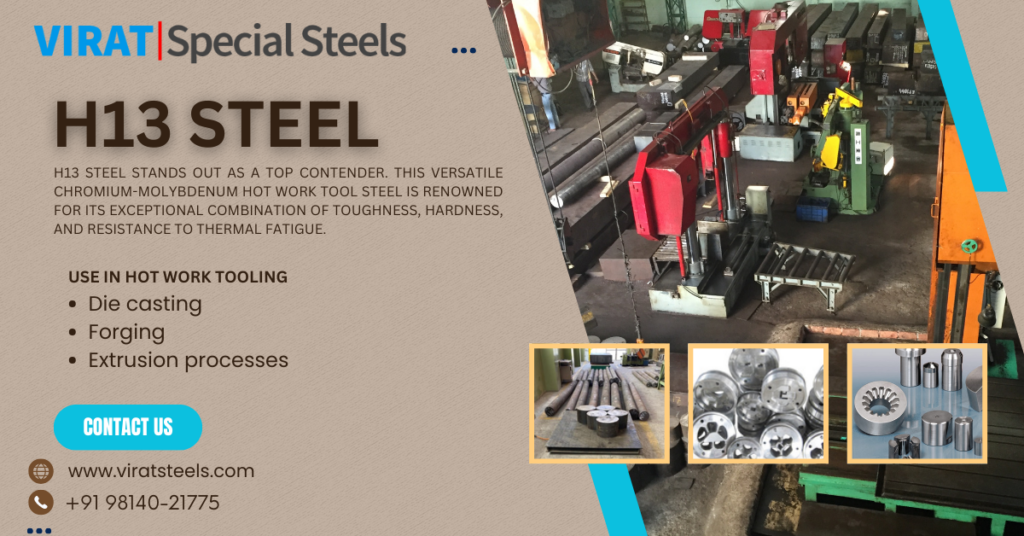What is H13 Steel and Its Applications?
Introduction
When it comes to materials that can withstand extreme conditions, H13 steel stands out as a top contender. This versatile chromium-molybdenum hot work tool steel is renowned for its exceptional combination of toughness, hardness, and resistance to thermal fatigue. Its unique properties make it indispensable across various industries, from automotive to aerospace.

Chemical Composition of H13 Steel
The remarkable characteristics of H13 steel are rooted in its specific chemical makeup. The typical composition includes:
- Carbon (C): 0.32 – 0.40%
- Chromium (Cr): 5.13 – 5.25%
- Molybdenum (Mo): 1.33 – 1.4%
- Vanadium (V): 1.0%
- Silicon (Si): 1.0%
- Manganese (Mn): 0.20 – 0.50%
Each element plays a pivotal role:
- Carbon enhances hardness and strength.
- Chromium improves hardenability and resistance to oxidation.
- Molybdenum increases toughness and high-temperature strength.
- Vanadium contributes to wear resistance and grain refinement.
- Silicon boosts strength and elasticity.
- Manganese aids in deoxidation during steel production.
This balanced composition ensures that H13 steel maintains its integrity under demanding conditions.
Physical Properties of H13 Steel
Understanding the physical properties of H13 steel provides insight into its performance in various applications:
- Density: Approximately 7.80 g/cm³ (0.282 lb/in³)
- Thermal Conductivity: 24.3 W/m-K at 215°C (419°F)
- Coefficient of Thermal Expansion: 11.0 µm/m-°C between 25°C and 95°C
These properties indicate that H13 steel can efficiently conduct heat while maintaining dimensional stability, crucial for tools exposed to rapid temperature changes.
Mechanical Properties of H13 Steel
The mechanical prowess of H13 steel is evident in its ability to withstand substantial stress without deformation:
- Hardness: Rockwell C scale hardness ranges from 28 to 53, depending on heat treatment.
- Tensile Strength: Ultimate tensile strength can reach up to 1990 MPa (289,000 psi).
- Toughness: Demonstrates excellent toughness, essential for resisting cracking under impact.
These attributes make H13 steel suitable for applications requiring both strength and durability.
Heat Treatment Processes for H13 Steel
To optimize its properties, H13 steel undergoes specific heat treatment processes:
- Annealing: Heating to 1550°-1650°F, holding until uniformly heated, then cooling slowly to about 1000°F to soften the steel for machining.
- Hardening: Heating to 1800°-1850°F, followed by air or oil quenching to achieve desired hardness.
- Tempering: Reheating to 1000°-1150°F, depending on the required hardness, to reduce brittleness.
These treatments enhance the steel’s performance in various applications.
Advantages of Using H13 Steel
H13 steel offers several notable benefits:
- High-Temperature Resistance: Maintains strength and hardness at elevated temperatures, making it ideal for hot work applications.
- Wear Resistance: The presence of vanadium carbides provides excellent resistance to abrasion.
- Thermal Fatigue Resistance: Can withstand repeated heating and cooling cycles without cracking.
These advantages contribute to its widespread use in demanding environments.
Applications
1. Applications in Hot Work Tooling
H13 steel is widely used in hot work tooling applications where materials are subjected to high temperatures and extreme mechanical stress. Some of its key applications in this domain include:
- Die Casting Dies: H13 steel is commonly used for die-casting dies due to its excellent heat resistance, wear resistance, and toughness. The ability to withstand the rapid heating and cooling cycles involved in die-casting operations ensures longer tool life.
- Extrusion Dies: In aluminum and other metal extrusion processes, H13 steel is used to manufacture dies that shape and form metal billets. The steel’s strength and thermal stability prevent premature wear and deformation.
- Forging Dies: H13 steel is used in the production of forging dies that shape metal parts through high-pressure impacts. The toughness and heat resistance of H13 help the dies maintain their shape under extreme conditions.
These applications make H13 an indispensable material in the hot work tooling industry, ensuring efficiency, precision, and durability.
2. Applications in Cold Work Tooling
Although primarily known for hot work applications, H13 steel also finds limited usage in cold work tooling where wear resistance and impact strength are required. Some examples include:
- Shear Blades: H13 steel is used for manufacturing shear blades that cut or trim metal sheets, where its hardness and durability contribute to precision and long service life.
- Stamping Dies: H13 is occasionally used in stamping dies for cold-forming applications, where its wear resistance helps maintain die integrity.
- Plastic Molds: While more common in hot work environments, H13 is also used for plastic injection molding where high strength and heat resistance are necessary.
Although other cold work steels like D2 or O1 may be preferred for most cold work applications, H13’s versatility allows it to be used where both wear resistance and toughness are required.
3. Use in Plastic Injection Molding
H13 steel is one of the top choices for plastic injection molding tools, particularly for mold inserts. Some advantages include:
- High Thermal Conductivity: Ensures efficient heat dissipation, reducing cycle times and improving productivity.
- Wear and Corrosion Resistance: Prevents mold degradation, ensuring longevity and consistent production quality.
- Dimensional Stability: H13 maintains its structure under high pressure and temperature, reducing warping and defects in molded parts.
These properties make H13 a preferred material for injection molding applications, where durability and precision are critical.
4. H13 Steel in the Automotive Industry
The automotive sector relies on H13 steel for various high-performance applications. Some of the most common uses include:
- Engine Components: H13 steel is used in manufacturing engine components such as cylinder heads, pistons, and exhaust valves, where high-temperature resistance is necessary.
- Structural Parts: Some automotive manufacturers use H13 in critical structural components that must withstand mechanical and thermal stress.
- Tooling for Manufacturing: Many of the dies and molds used in automotive production, including stamping dies and injection molds, are made from H13 steel.
The exceptional properties of H13 steel help improve the durability and performance of automotive parts and manufacturing processes.
5. H13 Steel in the Aerospace Industry
The aerospace industry demands materials with superior strength, heat resistance, and toughness. H13 steel meets these requirements and is used in:
- Turbine Blades: Due to its heat resistance, H13 is used in manufacturing certain aerospace turbine components exposed to high temperatures.
- Structural Components: Some aerospace structures, including landing gear and support brackets, benefit from the toughness of H13 steel.
With the aerospace industry constantly pushing for high-performance materials, H13 remains a strong candidate for demanding applications.
Conclusion
H13 steel is a versatile and high-performance material used in numerous industries, including automotive, aerospace, die-casting, and injection molding. Its unique combination of high-temperature resistance, wear resistance, and toughness makes it an ideal choice for hot work tooling and other demanding applications. While it has some limitations, proper heat treatment and machining techniques help maximize its benefits. Whether in the production of industrial tools, aerospace components, or plastic molds, H13 remains a top-tier tool steel for high-performance applications.
Mode of Supply
Virat Special Steels is the largest stockiest and supplier of H13 tool steel in flat, square and round bar. We provide steel in all sizes as your requirements. H13 die steel is available in flat, square and round shape. Consult our team who will assist you for h13 steel query.
FAQs
1. What makes H13 steel suitable for high-temperature applications?
H13 steel has excellent thermal fatigue resistance, high wear resistance, and superior toughness, making it ideal for high-temperature applications such as die casting and forging.
2. How does H13 steel compare to D2 tool steel?
H13 is better suited for high-temperature applications, while D2 is a cold work steel with superior wear resistance. Choosing between them depends on whether heat resistance or abrasion resistance is a priority.
3. Can H13 steel be welded?
Yes, H13 steel can be welded, but it requires preheating and post-weld heat treatment to prevent cracking and ensure structural integrity.
4. What industries commonly use H13 steel?
H13 steel is widely used in die-casting, plastic injection molding, aerospace, automotive manufacturing, and hot work tooling applications.
5. How does heat treatment affect H13 steel?
Proper heat treatment enhances H13 steel’s hardness, strength, and resistance to thermal fatigue, ensuring optimal performance in demanding applications.






